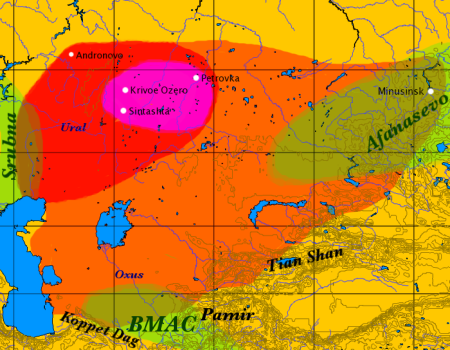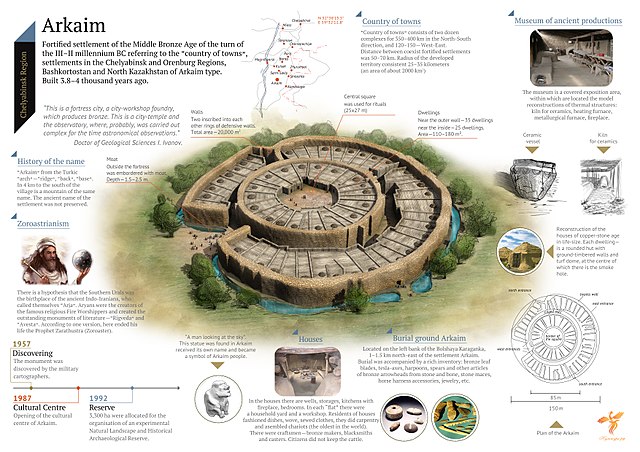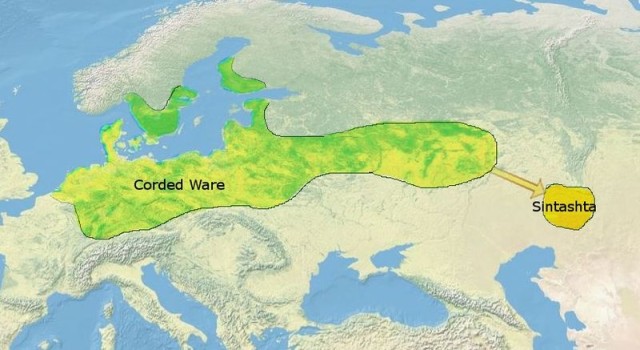
| SINTASHTA CULTURE
The Andronovo culture's approximate maximal extent, with the formative Sintashta-Petrovka culture (red), the location of the earliest spoke-wheeled chariot finds (purple), and the adjacent and overlapping Afanasevo, Srubna, and BMAC cultures (green).
Period
: Bronze Age
The Sintashta culture, also known as the Sintashta-Petrovka culture or Sintashta-Arkaim culture, is a Middle Bronze Age archaeological culture of the northern Eurasian steppe on the borders of Eastern Europe and Central Asia, dated to the period 2200–1800 BCE, or as recent publication by Stephan Lindner claims, based on another series of 19 calibrated radiocarbon datings, that the whole Sintashta-Petrovka complex belongs to c. 2050-1750 BCE. Although recently Ventresca Miller et al. still claimed a period of 2400-1800 BCE, based on 44 earlier C14 calibrated datings by Russian Academy of Sciences, which some other researchers consider to be outdated. The culture is named after the Sintashta archaeological site, in Chelyabinsk Oblast, Russia.
The Sintashta culture is thought to represent an eastward migration of peoples from the Corded Ware culture. It is widely regarded as the origin of the Indo-Iranian languages. The earliest known chariots have been found in Sintashta burials, and the culture is considered a strong candidate for the origin of the technology, which spread throughout the Old World and played an important role in ancient warfare. Sintashta settlements are also remarkable for the intensity of copper mining and bronze metallurgy carried out there, which is unusual for a steppe culture.
Origin
:
Morphological data suggests that the Sintashta culture might have emerged as a result of a mixture of steppe ancestry from the Poltavka culture and Catacomb culture, with ancestry from Neolithic forest hunter-gatherers.
Even though other researchers think it's an outdated chronology, Ventresca Miller et al. still claim that the first Sintashta settlements appeared around 2400 BCE and lasted until 1800 BCE with population estimates in each site ranging from 200 to 700 individuals, during a period of climatic change that saw the already arid Kazakh steppe region become even more cold and dry. The marshy lowlands around the Ural and upper Tobol rivers, previously favoured as winter refuges, became increasingly important for survival. Under these pressures both Poltavka and Abashevo herders settled permanently in river valley strongholds, eschewing more defensible hill-top locations. Ventresca Miller et al., also claims that "by 2300 cal BCE, Middle Bronze Age sites associated with Sintashta and Petrovka cultural groups in northern Kazakhstan heavily exploited domesticated cattle, sheep, and goats alongside horses with occasional hunting of wild fauna".
Its immediate predecessor in the Ural-Tobol steppe was the Poltavka culture, an offshoot of the cattle-herding Yamnaya horizon that moved east into the region between 2800 and 2600 BCE. Several Sintashta towns were built over older Poltavka settlements or close to Poltavka cemeteries, and Poltavka motifs are common on Sintashta pottery.
Sintashta material culture also shows the influence of the late Abashevo culture, derived from the Fatyanovo-Balanovo culture, a collection of Corded Ware settlements in the forest steppe zone north of the Sintashta region that were also predominantly pastoralist.
Society :
Linguistic
identity :
There is linguistic evidence of interaction between Finno-Ugric and Indo-Iranian languages, showing influences from the Indo-Iranians into the Finno-Ugric culture.
From the Sintashta culture the Indo-Iranian followed the migrations of the Indo-Iranians to Anatolia, India and Iran. From the 9th century BCE onward, Iranian languages also migrated westward with the Scythians back to the Pontic steppe where the proto-Indo-Europeans came from.
Warfare
:
Sintashta artefact types such as spearheads, trilobed arrowheads, chisels, and large shaft-hole axes were taken east. Many Sintashta graves are furnished with weapons, although the composite bow associated later with chariotry does not appear. Sintashta sites have produced finds of horn and bone, interpreted as furniture (grips, arrow rests, bow ends, string loops) of bows; there is no indication that the bending parts of these bows included anything other than wood. Arrowheads are also found, made of stone or bone rather than metal. These arrows are short, 50–70 cm long, and the bows themselves may have been correspondingly short.
Metal
production :
Much of Sintashta metal was destined for export to the cities of the Bactria–Margiana Archaeological Complex (BMAC) in Central Asia. The metal trade between Sintashta and the BMAC for the first time connected the steppe region to the ancient urban civilisations of the Near East: the empires and city-states of Iran and Mesopotamia provided an almost bottomless market for metals.
These trade routes later became the vehicle through which horses, chariots and ultimately Indo-Iranian-speaking people entered the Near East from the steppe.
Aerial view of the Arkaim site
View of the Arkaim site and surrounding landscape
Excavation and partial building reconstruction
Arkaim infographic
Chariot model, Arkaim museum Physical
type :
Genetics :
Allentoft 2015, published in Nature, the remains of four individuals ascribed to the Sintastha culture were analyzed. One male carried haplogroup R1a and J1c1b1a, while the other carried R1a1a1b and J2b1a2a. The two females carried U2e1e and U2e1h respectively. The study found a close autosomal genetic relationship between peoples of Corded Ware culture and Sintashta culture, which "suggests similar genetic sources of the two," and may imply that "the Sintashta derives directly from an eastward migration of Corded Ware peoples." Sintashta individuals and Corded Ware individuals both had a relatively higher ancestry proportion derived from the Central Europe, and both differed markedly in such ancestry from the population of the Yamnaya Culture and most individuals of the Poltavka Culture that preceded Sintashta in the same geographic region. The Bell Beaker culture, the Unetice culture and contemporary Scandinavian cultures were also found to be closely genetically related to Corded Ware. A particularly high lactose tolerance was found among Corded Ware and the closely related Nordic Bronze Age. In addition, the study found the Sintashta culture to be closely genetically related to the succeeding Andronovo culture.
Narasimhan 2019, published in Science, analyzed the remains of several members of the Sintashta culture. mtDNA was extracted from two females buried at the Petrovka settlement. They were found to be carrying subclades of U2 and U5. The remains of fifty individuals from the fortified Sintastha settlement of Kamennyi Ambar was analyzed. This was the largest sample of ancient DNA ever sampled from a single site. The Y-DNA from thirty males was extracted. Eighteen carried R1a and various subclades of it (particularly subclades of R1a1a1), five carried subclades of R1b (particularly subclades of R1b1a1a), three carried R1, two carried Q1a and a subclade of it, one carried I2a1a1a, and one carried P1. The majority of mtDNA samples belonged to various subclades of U, while W, J, T, H and K also occurred. A Sintashta male buried at Samara was found to be carrying R1b1a1a2 and J1c1b1a. The authors of the study found the Sintashta people to be closely genetically related to the people of the Corded Ware culture, the Srubnaya culture, the Potapovka culture, and the Andronovo culture. These were found to harbor mixed ancestry from the Yamnaya culture and peoples of the Central European Middle Neolithic. Sintashta people were deemed "genetically almost indistinguishable" from samples taken from the northwestern areas constituting the core of the Andronovo culture, which were "genetically largely homogeneous". The genetic data suggested that the Sintashta culture was ultimately derived of a remigration of Central European peoples with steppe ancestry back into the steppe. Some Sintastha individuals displayed similarites with earlier samples collected at Khvalynsk.
Source :
https://en.wikipedia.org/ |






